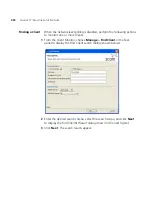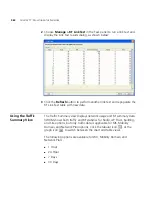
472
C
HAPTER
18: D
ETECTING
AND
C
OMBATTING
R
OGUE
D
EVICES
Rogue Detection
Lists
Rogue detection lists specify the third-party devices and SSIDs that MSS
allows on the network, and the devices MSS classifies as rogues. You can
configure the following rogue detection lists:
Permitted SSID list—A list of SSIDs allowed in the Mobility Domain.
MSS generates a message if an SSID that is not on the list is detected.
Permitted vendor list—A list of the wireless networking equipment
vendors whose equipment is allowed on the network. 3WXM
identifies the vendor of a piece of equipment by using the
Organizationally Unique Identifier (OUI). The OUI is the first three
bytes of the MAC address that the equipment uses. MSS generates a
message if an AP or wireless client with an OUI that is not on the list is
detected.
Rogue list—A list of AP MAC addresses to attack whenever they are
present on the network.
Client black list—A list of MAC addresses of wireless clients who are
not allowed on the network. MSS prevents clients on the list from
accessing the network through a WX switch. If the client is placed on
the black list dynamically by MSS due to an association, reassociation
or disassociation flood, MSS generates a log message.
Ignore list—A list of third-party devices that you want to exempt from
rogue detection. MSS does not count devices on the ignore list as
rogues or interfering devices, and does not issue countermeasures
against them.
An empty permitted SSID list or permitted vendor list implicitly allows all
SSIDs or vendors. However, when you add an entry to the SSID or vendor
list, all SSIDs or vendors that are not in the list are implicitly disallowed.
An empty client black list implicitly allows all clients, and an empty ignore
list implicitly considers all third-party wireless devices to be potential
rogues.
All of the lists except the black list require manual configuration. You can
configure entries in the black list, and MSS can place a client in the black
list due to an association, reassociation, or disassociation flood from the
client.
The rogue classification algorithm examines each of these lists when
determining whether a device is a rogue. The following figure shows how
the rogue detection algorithm uses the lists.
Содержание OfficeConnect WX4400
Страница 74: ...74 CHAPTER 4 WORKING WITH NETWORK PLANS...
Страница 92: ...92 CHAPTER 5 PLANNING THE 3COM MOBILITY SYSTEM Origin point...
Страница 164: ...164 CHAPTER 5 PLANNING THE 3COM MOBILITY SYSTEM...
Страница 244: ...244 CHAPTER 6 CONFIGURING WX SYSTEM PARAMETERS...
Страница 298: ...298 CHAPTER 7 CONFIGURING WIRELESS PARAMETERS...
Страница 344: ...344 CHAPTER 8 CONFIGURING AUTHENTICATION AUTHORIZATION AND ACCOUNTING PARAMETERS...
Страница 410: ...410 CHAPTER 14 MANAGING ALARMS...
Страница 457: ...Using the Client Summary View 457 The following screen provides a sample of the Top Clients option...
Страница 500: ...500 CHAPTER A CHANGING 3WXM PREFERENCES...
Страница 516: ...516 CHAPTER B CHANGING 3WXM SERVICES PREFERENCES...
Страница 522: ...522 APPENDIX C OBTAINING SUPPORT FOR YOUR 3COM PRODUCTS...
Страница 528: ...528 INDEX WX WX security enabling 67 X X 509 certificate types 383...
















































